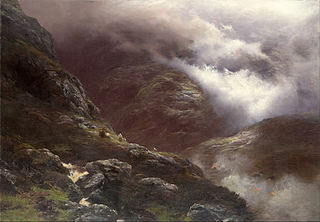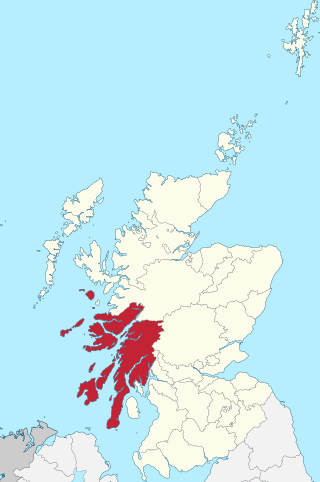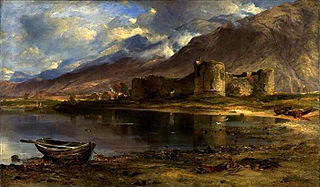
Glencoe or Glencoe Village is the main settlement in Glen Coe in the Lochaber area of the Scottish Highlands. It lies at the north-west end of the glen, on the southern bank of the River Coe where it enters Loch Leven.

The Massacre of Glencoe took place in Glen Coe in the Highlands of Scotland on 13 February 1692. An estimated 30 members and associates of Clan MacDonald of Glencoe were killed by Scottish government forces, allegedly for failing to pledge allegiance to the new monarchs, William III and Mary II.

Clan Campbell is a Highland Scottish clan, historically one of the largest and most powerful of the Highland clans. The Clan Campbell lands are in Argyll and within their lands lies Ben Cruachan. The chief of the clan became Earl of Argyll and later Duke of Argyll.

Archibald Campbell, Marquess of Argyll, 8th Earl of Argyll, Chief of Clan Campbell was a Scottish nobleman, politician, and peer. The de facto head of Scotland's government during most of the conflict of the 1640s and 1650s known as the Wars of the Three Kingdoms, he was the main leader of the Covenanter movement that fought for the Establishment of Presbyterianism in opposition to the preference of King Charles I and the Caroline Divines for instead Establishing both High Church Anglicanism and Bishops. He is often remembered as the principal antagonist to the Royalist general James Graham, 1st Marquess of Montrose.

Argyll, sometimes called Argyllshire, is a historic county and registration county of western Scotland. The county ceased to be used for local government purposes in 1975 and most of the area now forms part of the larger Argyll and Bute council area.
Glen Coe is a glen of volcanic origins, in the Highlands of Scotland. It lies in the north of the county of Argyll, close to the border with the historic province of Lochaber, within the modern council area of Highland. Glen Coe is regarded as the home of Scottish mountaineering and is popular with hillwalkers and climbers.

The Battle of Inverlochy occurred on 2 February 1645, during the Wars of the Three Kingdoms, when a Royalist force of Highlanders and Confederate Irish troops under the overall command of James Graham, 1st Marquess of Montrose, routed and largely destroyed the pursuing forces of Archibald Campbell, 1st Marquess of Argyll, who had been encamped under the walls of Inverlochy Castle.
Argyll's Regiment of Foot was a Scottish infantry regiment formed in April 1689 to suppress Jacobite opposition in the Highlands. In February 1692 it took part in the Glencoe Massacre, moved to Brentford near London in May then to Flanders in early 1693 where it fought in the Nine Years War. It became Lord Lorne's Regiment in April 1694 and was disbanded on February 1697.

Balquhidder is a small village in Perthshire located 10 miles (16 km) north-west of Callander. It is administered by the Stirling council area of Scotland and is overlooked by the dramatic mountain terrain of the 'Braes of Balquhidder', at the head of Loch Voil. Balquhidder Glen is also popular for fishing, nature watching and walking.
John MacDonald, known as Iain Lom was a poet and tacksman of Allt a' Chaorainn from Clan MacDonald of Keppoch, who composed war poetry in Scottish Gaelic. In addition to being appointed by King Charles II as the first Poet Laureate of Scotland, Iain Lom has long been considered to have a permanent place in the canon of Scottish Gaelic literature.

The Clan Henderson also known as House of Henderson is a Scottish clan. The clan's historical seat is at Fordell Castle in Dalgety Bay, Fife. The current clan chief is Alistair Henderson of Fordell.

Glen Lyon is a glen in the Perth and Kinross region of Scotland. It is the longest enclosed glen in Scotland and runs for 34 miles from Loch Lyon in the west to the village of Fortingall in the east.

The Appin Murder was the assassination by a concealed marksman of Colin Roy Campbell, the Clan Campbell tacksman of Glenure and Factor for the Forfeited Estates Commission, on 14 May 1752. The murder, which took place on the confiscated estate of Clan Stewart of Appin in Lochaber in the west of Scotland, was an act of violent resistance against the large scale clearances taking place on the estate during the aftermath of the Jacobite Rising of 1745. The assassination led to the trial and execution of James Stewart of the Glens, often characterized as a notorious miscarriage of justice. The murder also inspired events in Robert Louis Stevenson's 1886 novel Kidnapped and its sequel Catriona.

The MacDonalds of Glencoe, also known as Clann Iain Abrach, is a Highland Scottish clan and a branch of the larger Clan Donald. Named after Glen Coe, the MacDonalds lived there from the early 14th century, until the glen was largely abandoned during the Highland Clearances of the late 18th century.

Achallader Castle is a ruined 16th-century tower house under the shadow of Beinn Achaladair, about 3.5 miles north of Bridge of Orchy, Argyll and Bute, Scotland.
Events from the year 1692 in the Kingdom of Scotland.
Sir Duncan Campbell (1597–1645), 2nd Baronet and 6th Lord of Auchinbreck, was a Scottish landowner and soldier. He was commander of the Marquess of Argyll, Archibald Campbell's troops, (Covenanters) in Ireland.

Robert Duncanson, 1658 to May 1705, was a Scottish professional soldier from Inveraray; a retainer of the Earl of Argyll, he began his career during the 1685 Argyll's Rising, and is now best remembered for his involvement in the February 1692 Glencoe massacre.

The Battle of Lagganmore took place in 1646 at Lagganmore in Glen Euchar, west of Loch Scammadale. It was part of the Wars of the Three Kingdoms, though in this case the battle, which was fought largely between Highland clansmen, incorporated a long running feud between Clan MacDonald and Clan Campbell.

Lady of the Glen: A Novel of 17th-Century Scotland and the Massacre of Glencoe is a 1996 historical fiction novel by American author Jennifer Roberson. It is a re-telling of the 1692 Massacre of Glencoe, and focuses on the romance between Catriona of Clan Campbell and Alasdair Og MacDonald of Clan Donald, each from rival clans.

















